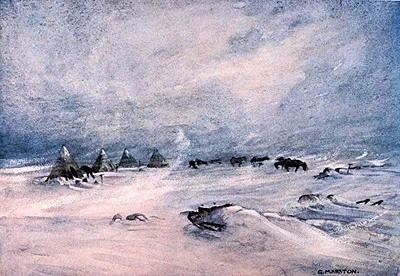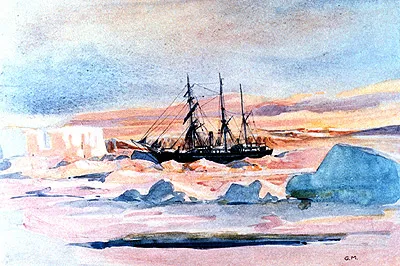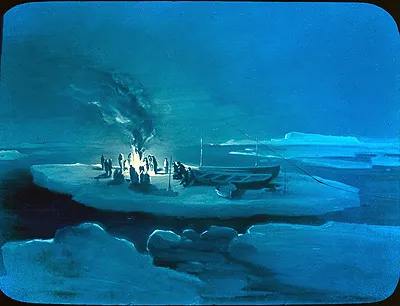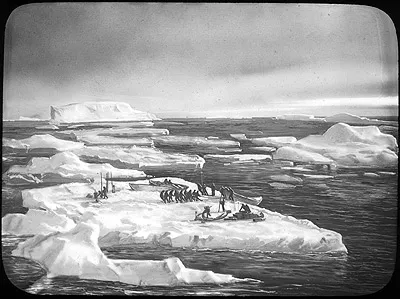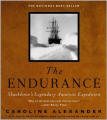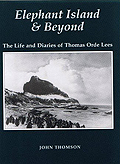George E. Marston, 1882-1940
Biographical notes
Artist Nimrod 1907-1909 | Official Artist Endurance 1914-17 | Paintings from the Nimrod Expedition
Antarctic Expeditions
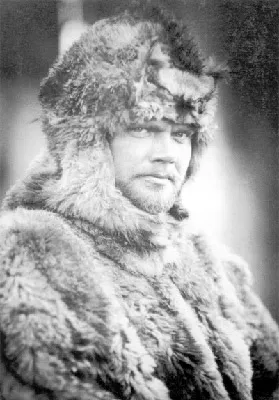
George Marston went twice to Antarctica with Ernest Shackleton, both times as the official expedition artist.
He took part in three sledging journeys on his first expedition on the Nimrod expedition, including an ascent of Mount Erebus.
He was a graduate of the Regent Street Polytechnic art school in London and joined the Nimrod expedition after being persuaded by Shackleton's two sisters with whom he was friends. He contributed several lithographs to the "Aurora Australis", a limited edition publication produced during 1908 whilst the men were laid up for the winter at Hut Point, and several paintings to "The Heart of the Antarctic" Shackleton's book of the expedition.
Marston was rather a moody individual, being up or down on an almost daily basis, he also had a tendency to be pessimistic and was somewhat disliked by Shackleton as a result of this.
He made sketches of life on the pack-ice and also Elephant Island, once again contributing to Shackleton's official account of the expedition. Marston made a not inconsiderable sacrifice on Elephant Island in giving up his oil paints to be used to help caulk the James Caird for the journey to South Georgia.
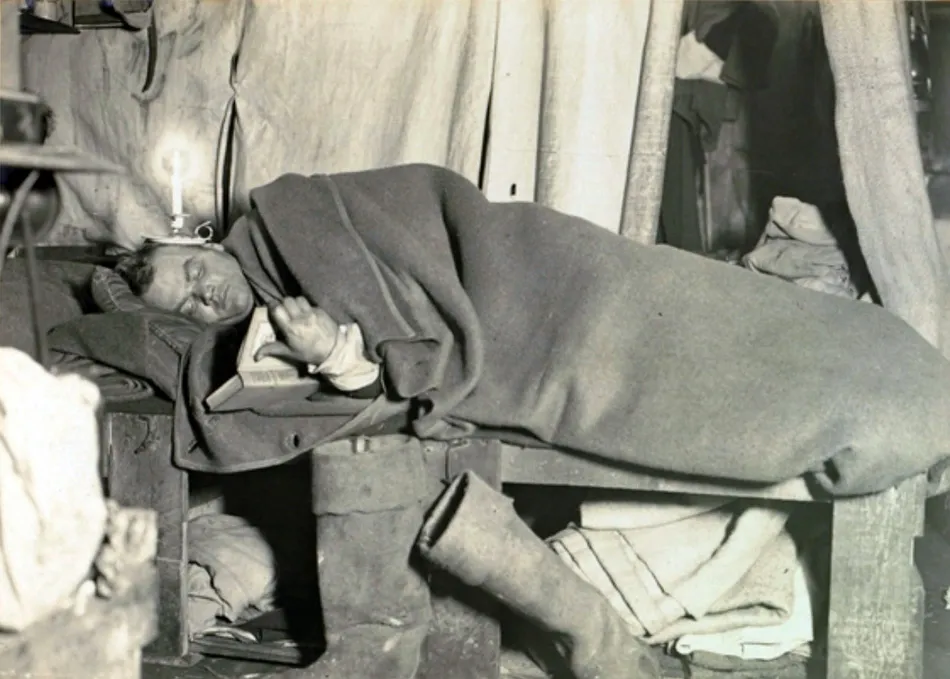
George Marston in his cubicle
on the Nimrod expedition in 1908 in the Cape Royds hut.
More of George Marston's Paintings from the Nimrod Expedition
Marston's paintings of the three lifeboats journey to Elephant Island after the ice broke up, Endurance expedition
Biography
George Marston was born in Southsea, Portsmouth on the 19th of March 1882, the son of a coach builder. Prior to going to Antarctica, he worked as a School Board Art Teacher. He had married to Hazel Roberts in 1913, in October of the same year, a daughter, Heather was born.
Shackleton was keen to recruit Marston as artist on the Endurance and was one of the first people he signed up, being promised a salary of £350 per year. As well as being artist, Marston was assigned as a dog-team leader and driver.
On return from the expedition Marston taught at Bedales school in Petersfield from 1918 to 1922. In 1925, he joined the Rural Industries Bureau (RIB) as Handicrafts Adviser, having always been a lover of rural life and countryside matters, he was appointed Assistant Director in 1931 and Director in 1934.
The job for the R.I.B. involved travelling
around England, Wales and Scotland, the administrative centres
being London and Taunton, Somerset. George split with Hazel
and they lead separate lives though they never divorced.
Marston died on the 22nd of November 1940 in Taunton
of a coronary thrombosis at the age of 58, he is buried
in the village churchyard at East Lyng, near Taunton, a
sailing ship adorns his headstone.
References to George Marston by Orde-Lees in "Elephant Island and Beyond" buy USA buy UK
-
The training of dogs has commenced - soon their services will relieve us of a great deal of not unpleasant work in bringing in distant seals. Wild, Marston, Crean, Macklin, McIlroy and Hurley are the dog men: none of them has any preliminary experience to speak of, but this does not seem at all essential.
-
Marston, our affable artist, repairs all our boots, sewing new soles on them in quite a professional manner. He is wonderfully handy at certain things, once he gets started, but he is inclined to be a little lethargic and takes a bit of starting at times. He, Wild, Captain Worsley and Tom Crean live in the original upper deck ward room, just above the hold. They have divided the space up into four cubicles and so have one each, quite a luxury. They look like little horse-boxes, so are always alluded to as The Stables.
-
Marston has ideas of his own, mainly artistic, and so has fixed up a sort of opium deb settee about 4ft by 4 and a half ft which really occupies almost the entire available space of the cubicle. It is covered with fine reindeer skins which he as clothing officer is in charge of and really it is a delightful nest, but how he manages to curl up at night is a puzzle. He is by no means tall, which is lucky, and so he probably fits in diagonally and draws his knees up a bit for the rest.
-
Marston, ever a born actor and artists, was beautifully made up as an old yokel farm hand in a smock with fur whiskers, in which guise he sang Widdicome Fair with fine action, and later as a human derelict he favoured us all with a bloodcurdling rendering of a gruesome song entitled Johnny Hall.
-
Marston is busy with his painting, working up sketches by artificial light. He is much to my liking. He is one of those solid, comfortable people, square in his nature and appearance, who inspire confidence. His genuineness and integrity are his most outstanding features. He is, in a way, extremely versatile, being an excellent artist and a really good singer and actor, but he is hardly what is called industrious, and yet when he has anything to do which necessitates calling into play any handicraft, his work is always beautifully finished. He will make a dog whip better than anyone, is quite a passable carpenter and, as a bootmaker, he soles and heels our ski boots better than we could ever get them done by any average professional repairer. Certainly he never goes out of his way to look for work, but when it comes his way he does it thoroughly. On the other hand he is no shirker and always does his share when it is a case of "all hands".
-
Marston, James and I were working down in the hold after extracting cases close by where the water was coming in and down there we could plainly hear the deadly stream of running water below us. Meanwhile the noise of the ship breaking up was deafening.
-
The morning was a truly beautiful one; we all got quite warm again rowing. Marston in the Dudley Docker enlivened us with songs and we all felt much happier than we had for several days, confident this time of making the land.
-
The second question, that of shelter, was much harder to solve owing principally to the unsuitability of the available stones for building purposes, and entire lack of any timber or other material with which to form even a framework for a roof. The manner in which it was eventually overcome does Marston and Greenstreet, whose suggestions were acted upon, much credit.
-
Marston had gone up Penguin Hill to make some thumbnail sketches, as is his wont, and Hurley had joined him. We heard the former pattering and panting along up the path to the Sty. "Wild, there's a ship", he said excitedly. "Shall we light a fire?".
References to George Marston in Shackleton's book "South!" buy USA buy UK
- The new quarters became known as "The Ritz," and meals
were served there instead of in the ward room. Breakfast
was at 9 a.m., lunch at 1 p.m., tea at 4 p.m., and dinner
at 6 p.m. Wild, Marston, Crean, and Worsley
established themselves in cubicles in the wardroom, and
by the middle of the month all hands had settled down to
the winter routine.
- The few pieces of wood that we had were laid across
from keel to keel, and over this the material of one of
the torn tents was spread and secured with guys to the rocks.
The walls were ingeniously contrived and fixed up by
Marston. First he cut the now useless tents
into suitable lengths; then he cut the legs of a pair of
seaboots into narrow strips, and using these in much the
same way that the leather binding is put round the edge
of upholstered chairs, he nailed the tent-cloth all round
the insides of the outer gunwales of the two boats in such
a way that it hung down like a valance to the ground, where
it was secured with spars and oars.
- "Our reading material consisted at this time of two
books of poetry, one book of Nordenskjold's Expedition,'
one or two torn volumes of the 'Encyclopaedia Britannica,'
and a penny cookery book, owned by Marston.
Our clothes, though never presentable, as they bore the
scars of nearly ten months of rough usage, had to be continually
patched to keep them together at all."
- A huge glacier across the bay behind the hut nearly
put an end to the party. Enormous blocks of ice weighing
many tons would break off and fall into the sea, the disturbance
thus caused giving rise to great waves. One day
Marston was outside the hut digging up the frozen
seal for lunch with a pick, when a noise "like an artillery
barrage" startled him. Looking up he saw that one of these
tremendous waves, over thirty feet high, was advancing rapidly
across the bay, threatening to sweep hut and inhabitants
into the sea. A hastily shouted warning brought the men
tumbling out, but fortunately the loose ice which filled
the bay damped the wave down so much that, though it flowed
right under the hut, nothing was carried away. It was a
narrow escape, though, as had they been washed into the
sea nothing could have saved them.
- "The centre of the hut is filled with the cases which
do duty for the cook's bed, the meat and blubber boxes,
and a mummified-looking object, which is Lees in his sleeping-bag.
The near end of the floor space is taken up with the stove,
with Wild and McIlroy on one side, and Hurley and James
on the other. Marston occupies a hammock
most of the night - and day - which is slung across the
entrance. As he is large and the entrance very small, he
invariably gets bumped by those passing in and out. His
vocabulary at such times is interesting.
- Marston had with him a small penny
cookery book. From this he would read out one recipe each
night, so as to make them last. This would be discussed
very seriously, and alterations and improvements suggested,
and then they would turn into their bags to dream of wonderful
meals that they could never reach.
- We were just assembling for lunch to the call of 'Lunch O!' and I was serving out the soup, which was particularly good that day, consisting of boiled seal's backbone, limpets, and seaweed, when there was another hail from Marston of 'Ship O!' Some of the men thought it was 'Lunch O!' over again, but when there was another yell from Marston lunch had no further attractions.
Landmarks named after George Marston
Feature Name:
Mount Marston
Feature Type: summit
Elevation:
1245
Latitude: 76°54'S
Longitude: 162°12'E
Description:
A whaleback-shaped mountain, 1,245 m, standing at the
N side of Kar Plateau,
3 mi N of the terminus of Mackay Glacier
in Victoria Land. First mapped by the BrAE (1907-09).
Variant
Name(s) - Whaleback
Other Crew of the Endurance Expedition
Bakewell,
William - Able Seaman
Blackborow,
Percy - Stowaway (later steward)
Cheetham,
Alfred - Third Officer
Clark, Robert S.
- Biologist
Crean, Thomas
- Second Officer
Green, Charles J.
- Cook
Greenstreet,
Lionel - First Officer
Holness, Ernest
- Fireman/stoker
How, Walter E.
- Able Seaman
Hudson, Hubert T.
- Navigator
Hurley, James Francis
(Frank) - Official Photographer
Hussey,
Leonard D. A. - Meteorologist
James,
Reginald W. - Physicist
Kerr, Alexander.
J. - Second Engineer
Macklin,
Dr. Alexander H. - Surgeon
Marston,
George E. - Official Artist
McCarthy, Timothy
- Able Seaman
McIlroy, Dr. James
A. - Surgeon
McLeod, Thomas
- Able Seaman
McNish, Henry
- Carpenter
Orde-Lees, Thomas
- Motor Expert and Storekeeper
Rickinson, Lewis
- First Engineer
Shackleton,
Ernest H. - Expedition Leader
Stephenson,
William - Fireman/stoker
Vincent, John
- Able Seaman
Wild, Frank
- Second in Command
Wordie, James M.
- Geologist
Worsley, Frank
- Captain
Biographical information
- I am concentrating on the Polar experiences of the men involved.
Any further information or pictures visitors may have will be gratefully received.
Please email
- Paul Ward, webmaster.
What are the chances that my ancestor was an unsung part of the Heroic Age
of Antarctic Exploration?
Ernest Shackleton Books and Video

South - Ernest Shackleton and the Endurance Expedition (1919)
original footage - Video

Shackleton
dramatization
Kenneth Branagh (2002) - Video

Shackleton's Antarctic Adventure (2001)
IMAX dramatization - Video

The Endurance - Shackleton's Legendary Expedition (2000)
PBS NOVA, dramatization with original footage - Video
Endurance : Shackleton's Incredible Voyage
Alfred Lansing (Preface) - Book
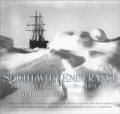
South with Endurance: Frank Hurley - official photographer
Book
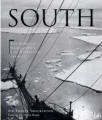
South! Ernest Shackleton Shackleton's own words
Book

Shackleton's Way: Leadership Lessons from the Great Antarctic Explorer
Book

